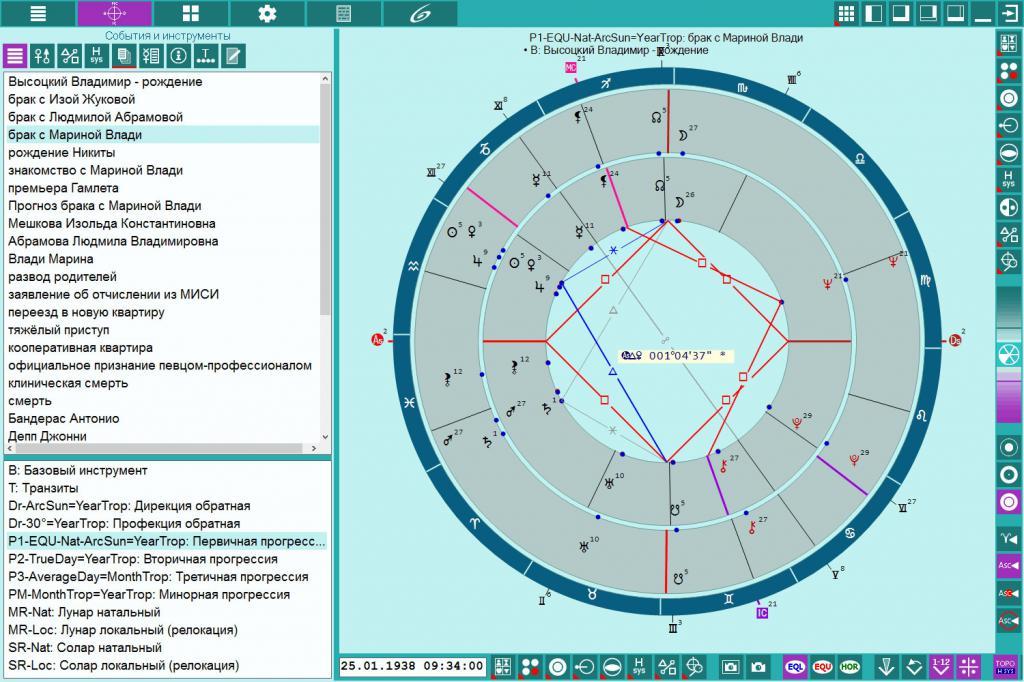There are two main forms of progression in astrology: secondary progression or “day after year” progression, and progression in the direction of the solar arc. Particular attention is paid to changes in the signs of the zodiac and houses, as well as the angles or aspects of progressive planets from the original natal chart.
Predictive astrology
Astrological progression is part of what is commonly called predictive astrology - a branch of astrology designed to predict or future trends and events. Most astrologers nowadays consider the term “prediction” not quite correct, since modern astrology does not pretend to directly predict future events as such. Instead, it is argued that the astrological picture in relation to the future may correspond to any of many possibilities. What is actually predicted is the tendency of circumstances and the nature of the individual’s reaction to the situation. In other words, the progressive and transitory motion of the planets indicates certain phases in a person’s life, while the potential shown on the natal chart will reflect the possibilities for the development of the situation under both favorable and unfavorable circumstances.
Progression and free will
All modern astrologers emphasize the role of free will in predictions. It is argued that astrology does not predict fate, but rather reveals the strengths and weaknesses, talents and capabilities of a person. The horoscope does not determine the future, but shows the possible paths that will be open to man and on the basis of which he will be able to make his own choices.
Modern astrologers argue that not a single planetary aspect determines fate as such, and the lion's share of future events really depends on the free will of man. Interpretation of progressions in astrology can only give him a chance to change what at first glance may seem inevitable.
The role of an astrologer is to create self-knowledge and awareness of the movement of the planets and their meaning, giving a person the opportunity to make reasonable and thoughtful life decisions. In short, modern astrologers usually do not predict real future events, but only claim that the future can be roughly outlined.
Secondary progressions in astrology
This progression involves moving the natal chart (chart) one day in advance each year of a person's life. So, for example, a person born on April 2, 1982, will develop a progressive schedule for 2007, based on the position of the planets on April 27, 1982 (i.e. 25 days for 25 years). Samples formed 25 days after the birth of a person are considered symbols of the 25th year of a person’s life and indicate potential trends over the course of the year. Secondary progressions are considered by most astrologers to be the most important form of progression.
Solar arc progression
This form of progression includes the entire natal chart, moving one degree forward for each year. Thus, in 2007, a person born on April 2, 1982 would have a progressive schedule, compiled on the basis of the position of the planets advanced 25 degrees forward from their position on this date of birth (it is important to note that this action creates a diagram of planetary positions, that never existed in real life). The name "progression of the solar arc" arose because the sun shifts about one degree per day, so the rest of the planet in this method, in a sense, is "forced to follow the sun." In other words, the planets move the same distance as the Sun in a secondary progression. Those astrologers who use the progression of the solar arc usually see it as an additional source of information that should be used in combination with secondary progression.
Interpretation
The interpretation of progressions in astrology is usually similar to the interpretation of transit. In general, however, progressions are closely associated with psychological events within a person (often, of course, caused by external events), while transits are associated with events in life circumstances that the individual cannot influence.
In astrology, decoding progressions plays an important role. But the most important point that should be remembered in connection with progressions is that the natal chart template always determines their value. So, for example, if the Sun and Mars are in a complex aspect on the natal chart, the positive or light aspect between the progressing Mars and the natal Sun will not bring the same expected benefits. In addition, if the planets are not aspected on the natal chart, progressive aspects, as a rule, will not have the same effect. In short, each person carries with him the whole picture of the natal chart, and the progressive and transitory movements of the planets indicate when the potential of the natal chart ripens for the further development of the life scenario.

As they say in books on astrology, the method of progression is usually important only for the inner personal planets (the Sun, the Moon, Mercury, Venus and Mars), since the progressing outer planets will only move a short distance. However, personal planets affect aspects of the transpersonal and outer planets. Significant events in the movement of a slowly moving body, such as retrograde status or direct progression, are also considered significant for many astrologers who use progression.
The sun is in progression
A period of great importance. Both psychologically and due to circumstances, time will ripen for important adjustments, organization and integration of the whole picture of your life due to the direction of the planet associated with the aspect of the sun.
Moon in progression
A period of about one month, when all the affairs and psychological aspects associated with the planet will be pronounced and accelerated. The advanced moon often acts as a “trigger” for activating patterns already established by other progressive planets.
Mercury in progression
Usually indicates changes and necessary adjustments, increased mental activity, travel and intellectual issues of rather high importance.
Venus in progression
A period of great importance in relation to emotional, personal and creative interests. It can mean marriage, love, creative work inspired by love, the birth of a child or an emphasis on the financial sphere.
Mars in progression
A period of increased activity, conflict, and new ventures. Energy should be controlled, any impulsive decisions should be avoided. A period more prone to accidents. It may be the perfect time to take the initiative in your own hands or solve complex work.
Retrograde planetary motion
The retrograde motion of a planet is its apparent backward movement through the sky caused by the earth moving past a slower moving outer planet, or when the Earth itself passes faster than a moving planet. For the secondary progression or the day after year method, retrograde motion means that the progression of the planet forward by one day causes the planet to move “backward” in the diagram counterclockwise. In astrology, this movement has traditionally been considered unsuccessful or unfavorable, since it contradicted the "natural" order of movement (or "direct movement"), and the planet, retrograde at the time of birth, was considered a vulnerable point on the natal chart.

Most modern astrologers consider retrograde planetary motion to be an indicator of tension or difficulty, although this is often only mentioned with respect to transit planets. For example, Mercury's retrograde movement is believed to mean communication difficulties, lost letters, verbal misunderstandings and travel delays, as well as frustrations in people. However, some astrologers do not see the change from direct to retrograde movement as a clearly bad sign, especially considering that the outer planets are retrograde more than 40% of the time. Slow progressions in astrology, to be sure, are far from rare. For this reason, many modern astrologers generally believe that the significance of the retrograde movement is exaggerated, and it does not play any special role.
One way or another, the true meaning of retrograde movement in the natal chart is still not fully understood.